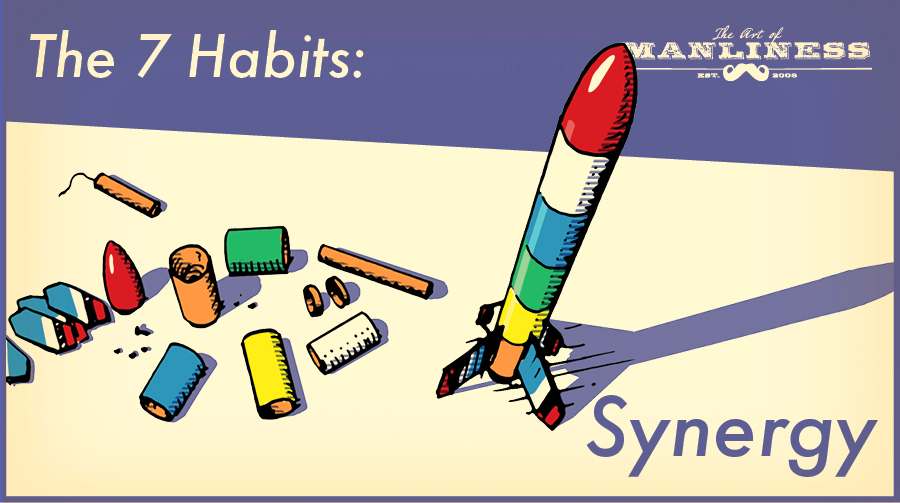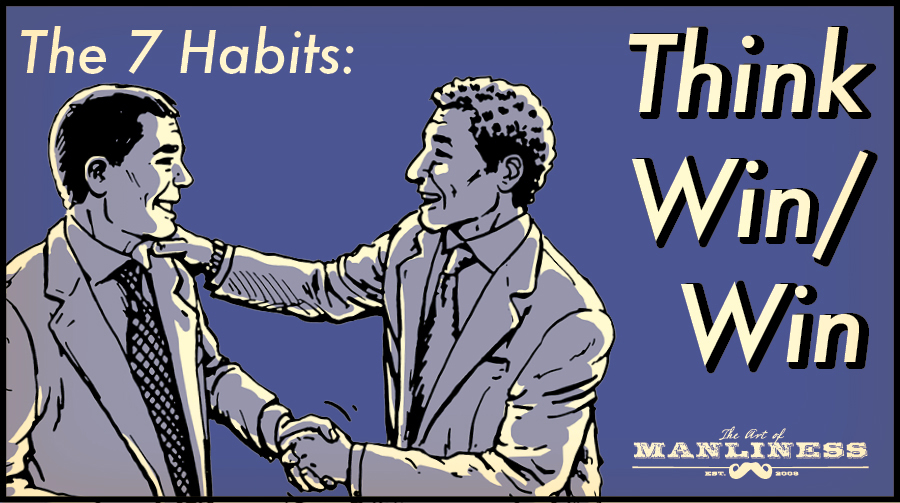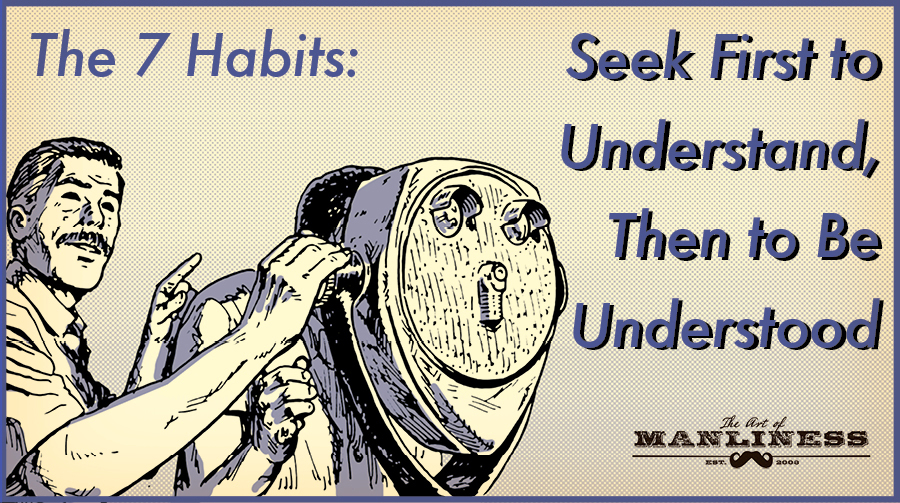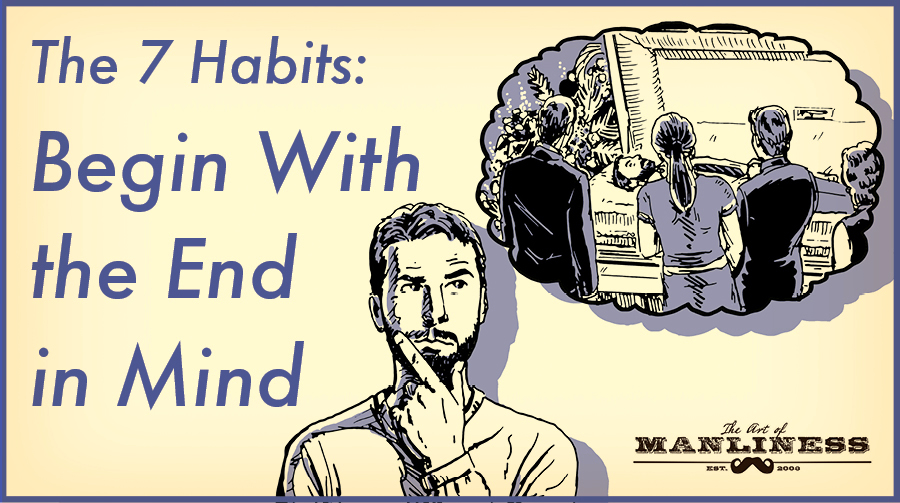
Welcome back to our monthly series that summarizes, expands, and riffs on each of the seven habits laid out in The 7 Habits of Highly Effective People by Stephen Covey.
Synergy.
It’s a word that’s apt to induce an eye-roll these days.
For the past few decades, synergy has been a banal business buzzword — a cliché term used to describe some splashy new initiative that really doesn’t amount to anything more than some corporate merging or bureaucratic reshuffling. Sometimes it’s even code for “We’re about to lay people off, but we’ll be able to get more done because . . . synergy!”
It’s not as if the term was originally more meaningful and simply became diluted over time. While Steven Covey helped popularize the buzzword in the mid-90s by making Synergy one of the habits in The 7 Habits of Highly Effective People, it’s arguably the weakest chapter in the book. While Covey describes Synergy in a way that transcends corporate strategy — as embracing differences between people as a spur to creative collaboration — the tips he gives to implement it are largely a vague rehashing of the previous habits, particularly “Think Win/Win.”
Covey even admitted as much in his 2011 book The 3rd Alternative, in which he revisits the concept of synergy, and tries to flesh out the details and concrete steps that were previously lacking in The 7 Habits. Even here though, synergy doesn’t emerge as a very distinct and compelling practice.
Perhaps there is just something about the idea of synergy that lends itself to being described in generalities, and which has made it the perfect rationale for pitching new business strategies that otherwise lack supporting evidence!
But, overused and ambiguous as it often can be, I don’t think synergy should be written off altogether. It can be a graspable, actionable habit, and a fruitful, effective one at that.
Synergy may not be redeemable as corporate lingo, but it’s a valuable strategy to implement in one’s personal life — allowing you to do more and be more than you otherwise could.
What Is Synergy?
Synergy comes from the Greek word for “working together.”
Synergy happens when two or more independent things combine into a whole that’s greater than the sum of its parts. The combination creates a power or effect that surpasses what the individual elements could achieve separately. In a simple win-win situation, each party gets their own benefit; in a synergy situation, a shared benefit is created that encompasses and transcends the two entities. If 1 + 1 normally equals 2, 1 + 1 + a syngeristic effect = 3.
Synergy can create a tangible effect/output and/or something new/different that didn’t exist when certain elements were kept separate. Hydrogen plus oxygen makes water. If one person who is too short to pick apples off a tree stands on the shoulders of someone else who is too short, the result is enough height to successfully pick fruit. Drums, vocal singing, and guitars can all make music separately; together they can create rock ‘n roll. Even simply using any kind of tool produces synergy; you + a computer can create things that a human and a laptop cannot create as independent elements.
Synergy also occurs when you complete two tasks with one action. The value created from the combination is the time saved over what would have been required in doing each task separately. If I fold laundry while listening to a podcast, I create more time for myself than if I had done each activity on its own.
Synergy and Your Roles in Life
In his book, First Things First (dude wrote a lot of books), Covey made an almost throwaway reference to synergy that I think is actually his most valuable insight about it: you should seek synergy between your different roles in life.
In the habit “Begin With the End in Mind,” one of your tasks is to uncover all the different roles you embody. So you might be a dad, a husband, an employee, a friend, a volunteer, a weightlifter, etc.
This is a really useful exercise because it gives you a big picture view of your responsibilities. But looking at that list can also give you the false and detrimental idea that each role is discrete and disconnected from the others.
That’s really how most of us live our lives, isn’t it? We have our work life, our social life, our gym life, our family life . . . and they’re all fairly separate and isolated from each other.
In some ways, that’s healthy; e.g., you don’t want to bring your work home with you all the time.
But there’s also a downside to failing to see each role as an interconnected part of a single system: it can make your life feel fractured and splintered and prevent you from being as happy and effective, in each role as well as in general, as you could be.
You’re having family problems which are exacerbated by your working long hours and not spending enough time at home, but you don’t feel like you can talk about personal problems at work, and don’t explain what’s going on to your boss or ask for time off. As a result, your home life continues to suffer, and, because you’re distracted, so does your work, though your boss doesn’t know why.
Or maybe you have a goal to start exercising and lose some weight, but you feel guilty about spending more time away from your family. So you don’t start that fitness program. But since you’re not exercising and taking care of yourself, you don’t have the energy and pep you need to make that time you spend with your family actually enjoyable.
Or perhaps you volunteer for a community organization, but the time and mental bandwidth it requires is taking time and mental bandwidth away from your girlfriend and work. So you resign.
Some amount of conflict will always exist between the different roles you inhabit in life. But with some thought and intentionality, you can not only reduce this tension, you can actually create healthy synergy between your roles and their attendant tasks.
How to Create Synergistic Effects in Your Life
There are two primary ways to create more synergy in your life: 1) complete two roles/tasks with one action, and 2) treat your life as an interconnected system.
Complete 2 Roles/Tasks Together
Synergy is created in your personal life when you combine two roles/tasks/activities together in a way that creates a power/effect/value that’s greater than doing them separately. Sometimes this value is simply in the time saved. But oftentimes there’s also a special effect created above and beyond this benefit in efficiency.
Multitasking has gotten a bad rap these days, but it shouldn’t always be thought of as verboten; there are in fact some activities that pair and layer so well together, that not only does the quality of each respective component not suffer, it actually improves.
Here are some examples of how to build this kind of synergy between your life’s roles and tasks:
- Do you have to travel a lot for work? Maybe take your wife and kids on one of your trips with you. During the day, you work, and in the evening you get out and explore with your brood. Employee role and family man role synergized.
- Another way you can reconcile work and family roles: see if it’s possible to work from home. You can eat lunch with your family and beat rush hour so you can spend more time with them. If you can’t work from home, go into work earlier, and come home earlier.
- Are you wanting to start exercising, but don’t want to spend more time away from your family? Exercise with your family. I’ve combined my love of weightlifting with my love of family by having a garage gym. While I’m training, the kids hang out with me and play outside. In between sets, I’ll often toss a football with Gus, kick a soccer ball with Scout, or talk to Kate. And when I travel for a weightlifting competition, I bring Gus along. I get to compete and I get to hang out with Gus for a couple days. It’s his favorite thing we do together and he’s always counting down to the next meet. When you exercise with your kids, you not only complete two tasks with one action, you create another powerful effect: instilling a love of fitness in your children.
- Use your commute as a time to listen to audiobooks or podcasts, or as a time of solitude in which you meditate or engage in self-examination.
- Do you want to spend some time volunteering, but don’t want to spend time away from your significant other? Do volunteer work with them. Not only will you get to spend quality time together, you’ll get to know each other in a more meaningful way.
- Do you have trouble finding time to exercise and/or finding time to spend with a friend? Commit to meeting up once a week to work out or go for a run or bike ride together. Not only will exercising with a friend create the kind accountability that ensures you’ll show up, doing something physical together creates an even stronger bond than if you had simply met for lunch.
- Same thing goes with a hobby you want to learn. Do you have a friend who has the same interest? Meet up regularly to work on the activity; the quality of both your skill and your bond will improve.
Treat Your Whole Life as an Interconnected System
Life synergy isn’t just about finding ways to accomplish two things at the same time.
It’s also vitally about learning to see all its different aspects as an interconnected system, that, as a whole, can generate a power far greater than the sum of its parts.
Rather than seeing each role and task in your life as separate, independent components, each cordoned off from the others and each with a limited value, realize they’re all interrelated and hugely influence each other. Once you realize this, you can start manipulating the number and kinds of these elements in your life so that they work together — compounding their value and making everything easier and better.
When you sleep well, it’s easier to eat right, and when you eat right, you see more results from your exercise and feel more motivated to work out, and when you work out, you feel more confident and energetic and get out and socialize more, and when you socialize more, you build a bigger social network, and when you build a bigger social network, you’re able to find a better, more satisfying job, and when you find a better, more satisfying job, it’s easier to be a more patient, present husband and father at home, and when you’re a more patient and present husband and father you sleep better . . .
And the arrows don’t just run in one direction.
When you have a calming home life and a supportive group of friends, you feel less depressed, and when you feel less depressed, it’s easier to focus at your job, or be motivated to find a better job, as well as to feel motivated to work out, and when you work out, you’re more motivated to not negate your sweat equity by eating junk and to stick with a healthy diet, and when you exercise and eat a healthier diet, you sleep better at night. And when you sleep better at night . . .
Your life is like an electrical circuit board, and the more positive pathways and amplifying connections you make, the more the power can build and flow.
Sometimes there’s a breaker in your life that’s interrupting the whole system; toxic friends who hold you back from your goals instead of helping propel you towards them; a misuse of leisure time that’s leaving you more restless and morose than clear-eyed and centered; a dead-end job you know you need to quit.
Sometimes removing a single blockage is enough to get the system running on all cylinders again.
Other times there’s a joint or junction that’s missing from the structure: a significant other that shares your values or a new hobby or an accountability group or a different morning routine. This connection can start circulating needed energy to areas that have been starved of it, which in turn will start pumping power into other areas . . . and soon the whole system is running stronger.
As you experiment with adding, subtracting, and mixing different roles and elements in your life, you can find the combinations that create the most synergy, maximize your effectiveness and fulfillment, and unlock your full potential.
Be sure to listen to my podcast with Stephen’s son about his father’s famous principles:
Read the Whole Series
- Be Proactive, Not Reactive
- Begin With the End in Mind
- Put First Things First
- Think Win/Win
- Seek First to Understand, Then to Be Understood
- Synergy (Beyond the Eye-Rolling Buzzword)
- Sharpen the Saw







